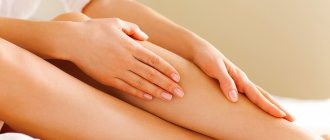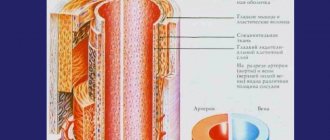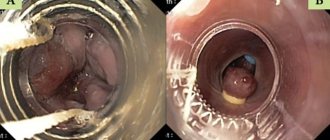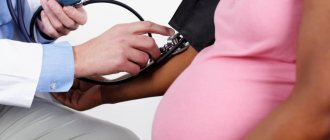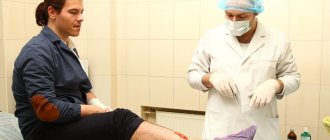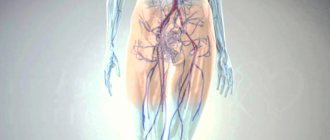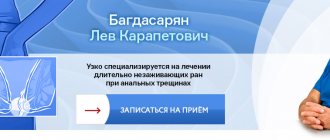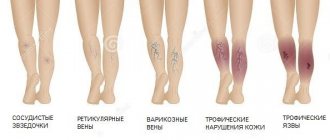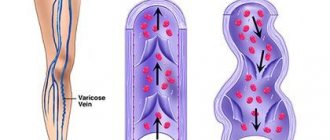Varicose veins on the legs, or simply varicose veins of the legs, are not only an aesthetic, but a serious physical problem for humans in modern society, which directly threatens life and health in the absence of proper therapy. Therefore, phlebology specialists. Vascular surgeons strongly advise that if you have dilated vessels, you should contact a medical facility. There are phlebologists at the MED CITY clinic in the center of Kyiv. With them we will try to understand all the modern methods of treating varicose veins that exist today [1].
According to the latest statistics, in the world more than 75% of women and about 60% of men in developed regions suffer from varicose veins. This means that the pathology of the vascular system has become global and is subject to detailed information to the general population in order to prevent its occurrence in the future.
How do varicose veins occur on the legs?
To have an idea of the reasons for the appearance of dilated veins, let us recall the structure of blood vessels in the lower extremities of a person. The blood in the veins, with each heartbeat, overcomes the laws of physics, moves from bottom to top. This process involves special venous valves that prevent blood from going down. It is the dysfunction of the valves of the venous vessels that provokes the occurrence and further development of varicose veins. There is an inevitable dilation of blood vessels, loss of their tone and an unpleasant aesthetic appearance of the limbs (especially on the legs).
There are several stages of varicose veins, each of which has its own characteristics.
In the first stage, a person does not feel any symptoms, except for minor discomfort in the legs, as well as a feeling of “heavy legs”. Depending on the individual characteristics of the body, fatigue in the legs can occur even after running or walking short distances [2].
The second stage, subcompensatory, is characterized by an increase in the characteristics of the first symptoms, as well as cramps, severe swelling, a tingling sensation or aching discomfort.
At the third stage, the skin on the legs, due to further expansion and deformation of the venous vessels, undergoes irreversible changes, namely:
- compaction of all superficial layers of the skin, as well as the dermis;
- formation of hyperpigmentation on the skin;
- constant swelling, regardless of the time of day;
- the occurrence of trophic ulcers due to an increased level of skin trauma.
Attention! When you reach the third, decompensation stage of varicose veins, you need to consult a doctor to prevent such serious complications of the disease as thromboembolism or thrombophlebitis.
The sooner you come to a qualified specialist in vascular pathologies, the better the prognosis for recovery will be. Depending on the stage of the disease, you must strictly follow all the recommendations of the phlebologist, as well as make adjustments to your lifestyle and give up bad habits.
Cure varicose veins
What do we have to do?
With varicose veins, the tone of the venous walls is reduced, so there is no need for them to put extra stress on them, but everything related to strengthening the veins and improving the quality of blood circulation is encouraged. Constantly being in an upright position is bad, but a sedentary lifestyle also impairs blood circulation:
- It is better to refuse work where you have to stand a lot;
- When working sedentary, avoid crossing your legs, crossing your legs, and even better, do small gymnastics, with a small number of squats and leg lifts, every hour;
- It is also worth doing a little exercise in the morning and evening;
- You should avoid strenuous sports and intense physical activity, because this is extra work for the blood vessels, and sometimes the main cause of varicose veins.
When going to bed, it is better to place your legs above body level. In general, you need to take care of your legs, so everything that could be the cause of varicose veins should be removed from your life. For example, flat feet can cause improper blood circulation in the leg - a factor that is best minimized by starting to wear orthopedic insoles.
Diagnosis of varicose veins in Kyiv
To determine the stage of development of varicose veins, a primary consultation with a phlebologist is first carried out, during which a face-to-face examination of the patient is carried out, an anamnesis is taken, a survey is carried out regarding the presence of a similar pathology in close relatives, as well as palpation of skin lesions with varicose veins found on the legs. To make an accurate diagnosis, the doctor must offer the patient a special ultrasound examination, called duplex scanning of the vessels of the lower extremities with mapping of blood flow in them. This is a painless procedure, during which the vascular surgeon determines the speed of blood flow and its direction in the vessels.
The medical clinic in Kyiv has installed modern ultrasound equipment, with the help of which it is possible to accurately determine the affected valves in the venous vessels, as well as mark the projection of the vessels on the skin. In the future, this will help to efficiently remove dilated veins during surgical removal of varicose veins [3].
After making an accurate diagnosis, localization, stage of varicose veins, and its morphological assessment, the doctor suggests undergoing treatment, which can be either conservative or surgical, using medical laser systems.
What to wear for varicose veins?
All periodic events must be assessed by the quality of their effect on the veins.
For example, coffee increases intravascular pressure - it is better not to abuse it; in a bathhouse the load on the veins increases - you need to steam in moderation. The same principle applies to clothing. It is better to avoid heels and tight, uncomfortable shoes altogether, and it is better to choose clothes that are loose and do not pinch your limbs. During the consultation, the phlebologist will definitely select the compression hosiery necessary for your varicose veins - you must wear it constantly. And detailed recommendations and a treatment plan are drawn up after examination and diagnosis - make an appointment!
Treatment of varicose veins on the legs using a conservative method
If the stage of the disease is early (first), then the main goal of therapy is to prevent the development of the disease to a more serious extent, as well as to stop the progression of varicose veins. In addition, conservative therapy is used if it is impossible to perform surgical intervention in a patient with varicose veins.
The main components of conservative therapy for varicose veins:
- the use of compression garments, as well as special bandages that have a compressive effect on the skin of the legs, thereby creating a constricting effect on the veins. This method of suppressing varicose veins is not prescribed in the presence of such serious diseases as aortoarteritis or atherosclerosis, in the presence of other inflammatory elements in the lower extremities;
- prescribing individual drug treatment, mainly ointments, with an anticoagulating, anti-inflammatory and tonic effect on the venous vessels. Each such drug has contraindications, so it is necessary to use them with extreme caution during gestation and lactation. In addition, regular measurement of blood clotting levels is an important factor.
The most common methods of treating varicose veins are surgical and laser. Among them:
Venectomy
Nowadays, this type of surgical intervention is performed in acute stages of thrombophlebitis, which is accompanied by a special complex structure of the patient’s venous vessels. A phlebologist surgeon ties the trunk of the dilated vein at the point where it flows into the deep veins (that is, crossectomy) and removes the trunk using surgical instruments [4].
The operation is performed under epidural anesthesia or general anesthesia. The duration of the intervention is about one and a half to two hours.
The disadvantages of venectomy are: frequent hematomas at the site of intervention, prolonged pain, the development of neuralgia due to damage to nerve fibers, as well as constant monitoring of physical activity on the affected limb.
Minimally invasive laser surgery for varicose veins "MED CITY"
These are low-traumatic methods of surgical interventions, which have replaced traditional venectomy, ensure good tolerance by patients, as well as a minimal likelihood of complications.
Endovasal laser coagulation of varicose veins
With the help of endovasal coagulation (or EVLC), it is possible to treat varicose veins on the legs of any stage, without restrictions on the thickness of the vein trunk. This is possible thanks to the use of the following tools by phlebologist surgeons:
- radial light guides for processing the internal channel of a venous vessel along the entire circumference;
- an automatic pump for filling the areas of the dermis surrounding the vein with an anesthetic, narrowing the vessel, and protecting tissue and muscles;
- a two-wave laser, one of the waves of which is absorbed by hemoglobin, and the second by the vessel wall.
No special preparation is required for endovasal coagulation. A face-to-face consultation with a phlebologist and an ultrasound scan of the veins of the lower extremities is sufficient, as well as a preoperative package of studies, including a coagulogram, general and biochemical blood tests.
During the intervention, the surgeon punctures the venous vessel, then inserts a thin catheter equipped with a light guide, after which it “seals” the vein with a two-wave laser under the control of an ultrasound machine. The duration of the operation is up to 40-50 minutes. A local anesthetic is used to relieve pain. After the procedure, the patient does not need to stay in the hospital hospital, but only wear compression garments for speedy healing of postoperative wounds for about five days.
Miniphlebectomy
A minimally invasive operation during which dilated nodes and their tributaries are removed through punctures from the venous vessels.
Note! Removal of the great and small saphenous veins using phlebectomy is impossible.
Preparation for miniphlebectomy is similar to the previous type of surgery for varicose veins: ultrasound examination of the veins, as well as laboratory tests.
The method has contraindications: the period of gestation and lactation, the presence of thrombophlebitis, infections in the acute phase, blood clotting pathologies, as well as disorders of the musculoskeletal function of the legs.
Miniphlebectomy lasts 40 minutes. After the intervention, wearing compression stockings is indicated.
Sclerotherapy for varicose veins
This technique is non-surgical and allows not only to eliminate varicose veins, but also the vascular network on the skin.
During sclerotherapy, a special preparation is injected into the vein through a puncture, which “glues” the walls of the venous trunk for further resorption of the latter. The MED CITY clinic uses the “foam-foam” technique, or foam sclerotherapy, the main advantage of which is a long stay in the vein and, as a result, increased efficiency. The operation is performed without anesthesia, since the phlebologist uses a very thin insulin needle to administer the active substance.
Contraindications for sclerotherapy for varicose veins are pregnancy and lactation, allergies to the drug, and immunodeficiency.
After sclerotherapy, you need to avoid heavy physical activity, do not visit saunas, do not sunbathe, and wear compression garments.
With the use of modern methods in medicine, varicose veins in our time have ceased to be a death sentence, but just a reason to turn to qualified specialists who will help cope with the dilation of venous vessels. Such doctors are ready to help at the MED CITY clinic in Kyiv.
Cure varicose veins
Ointment for varicose veins
Many patients go for help to a pharmacy that sells drugs against varicose veins for external use. Varicose veins are insidious, how best to treat and with what means? Here are some of them:
- Venoruton gel - contains rutin, which improves vascular tone and reduces swelling.
- Aescin gel is a drug based on horse chestnut extract and heparin, reduces the possibility of blood clots, relieves swelling and tones the veins.
- Ginkor Gel - created on the basis of the ginkgo biloba plant, eliminates swelling, increases the tone of veins and relieves inflammatory processes.
- Heparin ointment - eliminates the formation of blood clots and relieves pain.
But it is better not to be deceived by expecting immediate removal of varicose veins; you need to seek help from qualified specialists who will remove varicose veins. Treatment (the price for health cannot be high) will prevail.
